-
Car Reviews
- All reviews
- Midsize SUVs
- Small cars
- Utes
- Small SUVs
- Large SUVs
- Large cars
- Sports SUVs
- Sports cars
- Vans
Latest reviews
- Car News
-
Car Comparisons
Latest comparisons
- Chasing Deals
Need more space than a Model 3 provides? Tesla’s first midsize SUV, the Model Y, has landed in Australia in entry-level RWD and faster Performance AWD formats
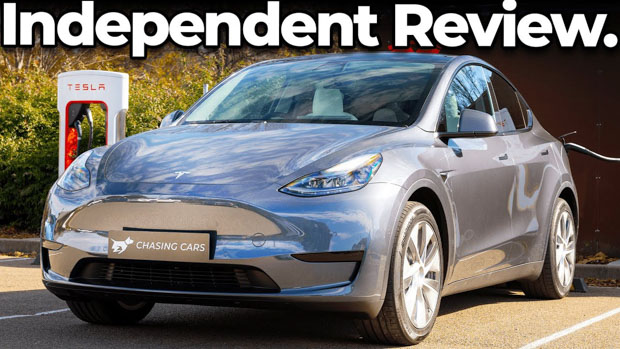
Following months of speculation and a pricing leak revealed by this masthead in May 2022, the much-anticipated Tesla Model Y – the first midsize SUV from the American electric car specialist – has now been released in Australia.
Chasing Cars understands around 7000 examples of the Model Y were ordered by Australian customers on the first day of local sales earlier in June, with the split noticeably in favour of the price-leading single-motor Rear Wheel Drive model we’re testing here – which cost $68,900 at the time we drove it before being repriced to $72,300 before on-road costs after a sudden price increase just days later.
That’s a lot of pent-up demand for Tesla’s family-sized SUV, with nearly two-thirds of the related Model 3 sedan’s 2021 sales recorded in a single day. Many buyers tell Chasing Cars they have been waiting to trade their Model 3 for a taller, larger vehicle – the raison d’etre of the Model Y – or that this will be their first EV.
Signs are good that Tesla will be able to supply at least a good proportion of these sales in 2022 thanks to a decent Australian allocation of cars set to be built at the company’s Giga Shanghai plant. Many of the Model Y’s direct rivals are deeply supply-constrained in Australia: Kia says it can deliver just 550 examples of the EV6 locally this year.
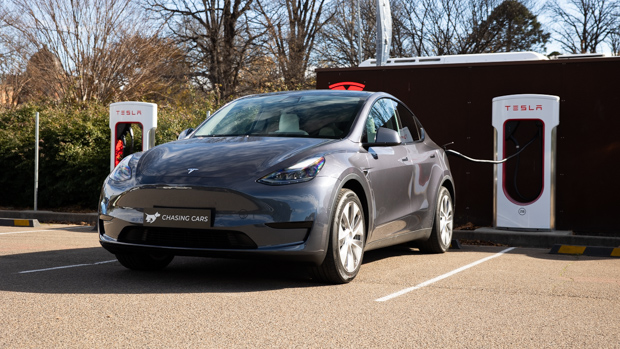
With Tesla making electric car life easier than any other brand – largely thanks to its moderately-sized but growing Supercharger network that is currently more reliable and easier to use than competing fast-charging networks like Chargefox and Evie – it’s hardly surprising that Australians are ravenous for the Model Y.
But with the number of practical electric vehicles in the semi-affordable $60K-$80K window growing rapidly, is the 2022 Tesla Model Y worth the spend? What does this electric crossover, on sale in the United States since March 2020, get right – and what does it get wrong?
The initial value question appears decently satisfied, even if the entry-level Model Y was bizarrely positioned just $150 above the threshold for a $3000 electric car purchase rebate in NSW when it went on sale last week.
That’s not bad considering the laundry list of included features: 170kW DC charging, a heat pump for greater efficiency in winter, a 15-inch touchscreen with a broad swathe of entertainment choices, double-glazed windows, HEPA filtering, five heated seats, a power tailgate and a premium stereo all being among them.
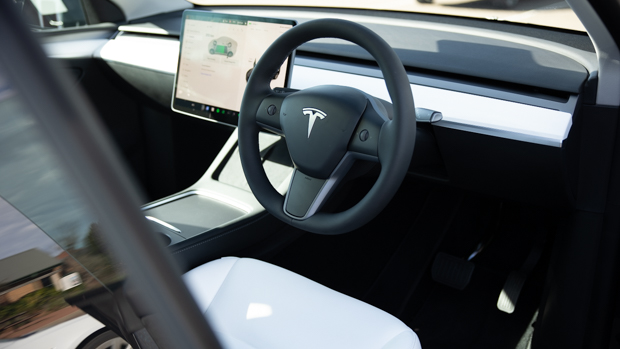
Spend a considerable $30,000 more on the Model Y Performance (now $96,700 before on-road costs) and you’re buying a supercar-quick family vehicle. An additional motor on the front axle adds AWD and about 50 percent more power, while 21-inch wheels, bigger brakes and a sports suspension give Tesla a direct rival to fast combustion crossovers like the BMW X3 M Competition ($166,500) and Mercedes-AMG GLC63 S ($178,824).
But unlike the existing Model 3 sedan – Australia’s best-selling electric car – the Model Y is hobbled in Australia from launch by not having a ‘goldilocks’ Long Range specification, bridging the substantial price gap between the RWD and Performance grades while giving families a more practical, longer-range vehicle – as the name suggests. A Long Range is available in many other Tesla markets.
For many buyers, waiting until Tesla adds the Model Y Long Range to the Australian lineup would be prudent. Our testing revealed that while the base-model Rear Wheel Drive represents good value, its real-world range of 375km is on the shorter side. When the Long Range model arrives for about $80,000, packing AWD, more power and a circa-500km range, it’ll be an even more well-rounded package for families.
Unlike the Hyundai Ioniq 5 or Kia EV6, Tesla have chosen to tune the Model Y to give it a noticeably sporty feel – even in the entry-level Rear Wheel Drive car. The $98K Performance grade might add a specific sports suspension, but even the base model is very stiff for a midsize SUV. This has upsides…and downsides.
On the positive side of the ledger, the Model Y has good body control, and it feels remarkably at-home on a curving Australian country road. Impressively well-weighted, quick and direct steering dovetails into the rigid chassis to give you confidence-inspiring high-speed cornering dynamics. It’s fun to drive hard!
Unfortunately, the stiff, passively-damped suspension that amps up the country-road dynamics means the low-speed, urban ride quality is poor. While the controlled damping makes the Model Y feel settled over speed humps, hit a square-edged bump or pothole in the suburbs and you’ll absolutely know about it. The brittle suspension fails to round off urban imperfections, sending a shock into the cabin. It’s a little awkward with passengers, as it’s clear the Model Y isn’t an especially comfortable car.
The ride quality is far from luxurious, and that is on the cushiest-possible wheel and tyre combination – 19-inch ‘Gemini’ wheels and Hankook tyres with the tallest-available sidewall for a Model Y. We strongly caution against optioning 20-inch wheels for the RWD as these will only cause further deterioration in the ride (due to less cushioning from a lower-profile tyre). We haven’t tested the Performance on its standard 21-inch wheels and variant-specific sports suspension.
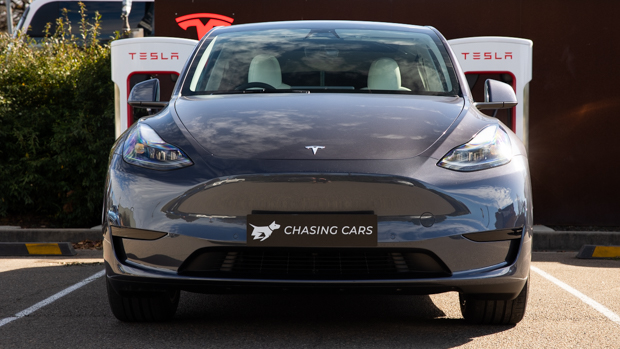
Compared to the deliberately soft, almost squishy ride of the Hyundai Ioniq 5 or the well-damped, Australian-tuned suspension of the Kia EV6, the Model Y feels behind the pace here. While the keen driver in us loves the Tesla’s composure at high speed, the compromise is not quite right for a vehicle that is first-and-foremost a family crossover that needs to be comfy. Leave the hard-riding shenanigans to the lightning-quick Performance grade.
Speaking of quick, the Model Y Rear Wheel Drive is…for the class that it sits in, but compared to other Teslas, the single-motor Model Y is not electrifying. Many readers asked us to verify Tesla’s 6.9sec 0-100km/h acceleration claim. We did, and the best result we could achieve from three runs in identical conditions was 7.15sec. That’s pretty warm performance, but the lower-set Model 3 RWD sedan is nearly a second quicker again, while Tesla claims the Model Y Performance does 0-100km/h in a 3.9sec.
Part of the reason for this seems to be software tuning, because the hardware is all there. Tesla does not claim a power or torque figure for the Model Y, though the car has been complied as having 220kW on tap from its single rear motor. No torque figure is available, though around 400Nm feels ballpark.
But while the mid-range torque is exceptional in the Model Y RWD – this SUV crushes the 80-120km/h overtaking benchmark – its off-the-line launch behaviour feels electronically restrained. This may be because the RWD model does not offer the ‘ludicrous’ driving mode the Performance gets – a setting that primes the battery and motors for a punchy launch.
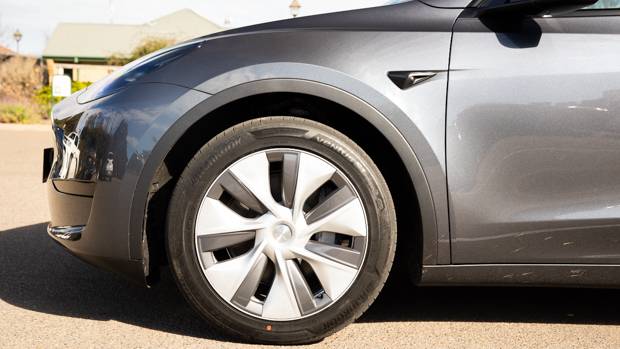
Still, the Model Y’s rear-mounted motor is smooth and silky with a tall single-speed gear that allows a top speed of 217km/h (extended to an impressive-for-an-EV 250km/h on the Performance). At normal Australian road speeds the motor is silent in the Model Y and refinement is pretty good, apart from suspension noise entering the otherwise-quiet cabin over bumps of any kind.
We commend Tesla for keeping the Model Y light – especially in RWD form. The manufacturer claims a kerb weight of about 1900kg but we weighed the car at an impressively restrained 1830kg. Much of this achievement is down to the Model Y’s efficiency – something Tesla, relatively experienced in battery and motor construction, gets very right. The efficient powertrain means the battery size can be lowered, though the 60kWh usable lithium-ion phosphate (LFP) battery might be a tad too compact for Australian use.
LFP batteries can be charged to 100 percent time-and-again without causing degradation, unlike lithium-ion or nickel-cobalt-aluminium batteries. That’s a good thing. But 60kWh isn’t huge, and our real-range of 375km achieved over 600km of urban, rural and highway testing averaging 16kWh/100km isn’t generous – especially when the Model Y RWD is rated for 455km range (WLTP). It’s worth noting the Performance claims a 514km range from its 76kWh usable battery.
Tesla completely buys into one-pedal driving with strong regenerative braking. Some EV-makers like Porsche and Mazda prefer to retain traditional brake-pedal usage, but like other Tesla cars before it, the Model Y is designed to be driven only through the accelerator pedal with the physical brakes only really there for emergency stops. Still, creep or hold functions for when the car is stopped are driver-selectable.
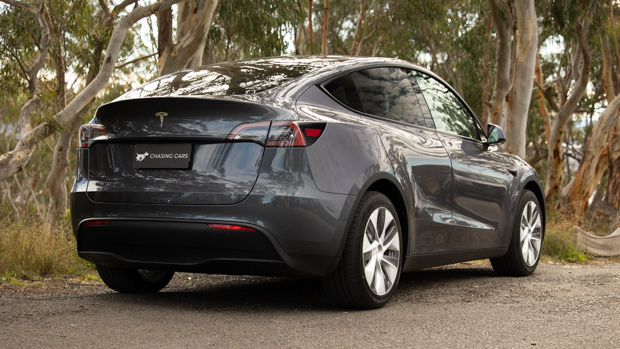
Forward visibility out of the Model Y is exceptionally good, and the mirrors are large, too – but the view out the back is obscured by the narrow aperture of the rear windows. Thankfully, blind-spot cameras are standard. These cams are clear enough, but given they are displayed through the Tesla’s only screen – centre mounted – you do have to turn your head to look at them, unlike the Ioniq 5, EV6 and Genesis GV60 which provide blind spot view in their instrument clusters.
As standard the Model Y has adaptive cruise control and a basic form of lane-keeping assist that is well-tuned but, frustratingly, disengages every time you change lanes. Avoiding this behaviour requires ticking the $10,100 so-called Full Self Driving option which upgrades to stronger lane-keep with lane-change automation and the as-yet unfulfilled promise of autonomous driving with software upgrades in future. This software is in beta-testing in some markets but it is not ready for public release.
All Model Y production for Australia is sourced from Tesla’s Giga Shanghai factory in China. Safety hardware is aligned for the Model Y worldwide to be camera-driven only rather than packing lidar sensors as backup. In our testing, we experienced two instances of ‘phantom’ autonomous emergency braking late in the day when shadows were long. Many online have reported this phenomenon.
If you’re moving from a combustion SUV or even another electric car – if it isn’t a Model 3 – you’ll be shocked at the level of minimalism on-show in the Model Y’s cabin. Simple, flowing shapes, a near-absence of physical controls and a single, centre-mounted 15-inch touchscreen are about all there is to see in here.
Specification-wise, there is a choice between standard black vinyl seats with real-wood ornamentation or $1500-optional white vinyl with ceramic-effect white trim. Our tester sported a tasteful Moonlight Silver/white interior that we’d probably specify if we were ordering a Model Y, but we’d be taking it straight to a detailer to have the upholstery treated and sealed.
We picked up ‘our’ Model Y with just 22km on the clock – box fresh! – and by 60km, we’d already noticed an unfortunate denim-blue smear on the 12-way electrically-adjustable, bone-white driver’s seat. Blame our preference for jeans. Thankfully, professionals can treat these seats to keep them looking newer for longer, and the vinyl material does wipe down easily.
One reason we’d choose the $1500 white interior is because, like the Model 3, the Model Y’s impressively huge glass roof (without any centre torsion bar) goes without a sun-blind. In our cool, 15-degree testing conditions, this was quite nice, warming the cabin in the afternoon sun…but in summer, with 30-40 degree heat, the cabin quickly bakes. You want to reflect as much of that light as possible.
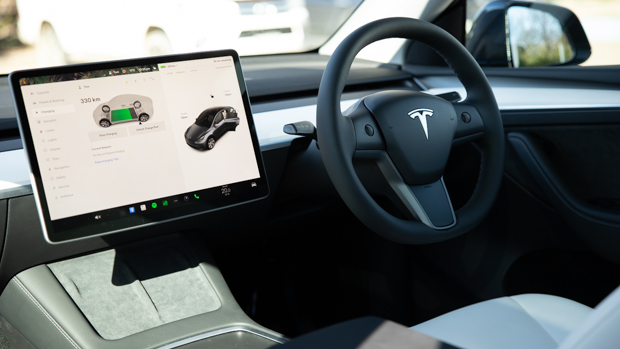
A previous experience with a Model 3 equipped with a black interior and standard glass roof had us sweating bullets. Unlike the Ioniq 5 and EV6, but like most variants of the Polestar 2, there is no seat cooling available in the Model Y (or 3), so on a hot day pumping the effective air conditioning, thereby sapping range, is your only option – and as we already noted, even the moderate-temperature range is middling.
Tesla is proud to say that its interiors are vegan, with no leather used. That’s fine, but vinyl seats in Australia need perforation at a minimum – and seat coolers wherever possible – to help keep the cabin temperate in our long, hot summer season. Cloth seats, which are also better for temperature regulation, are unavailable, as is natural leather (given the vegan promise).
Thankfully, the seats are comfortable – particularly the driver’s seat, which exclusively nabs four-way power lumbar adjustment to significantly boost back support. The passenger goes without this feature but retains eight-way power adjustment, and there is seat heating across all five seats. In the US, a tiny third row is optionally available but the dramatically-sloping roofline would make this all but unusable in our view.
Instead, the Model Y’s cabin is generously packaged for five, with a vast, airy feel afforded by the unusually-tall glasshouse and the transparent roof. The Model Y makes great use of its dedicated-electric architecture that eschews any accommodation for legacy features like a gearbox or driveshaft, so there is plenty of foot and knee space in every seat.
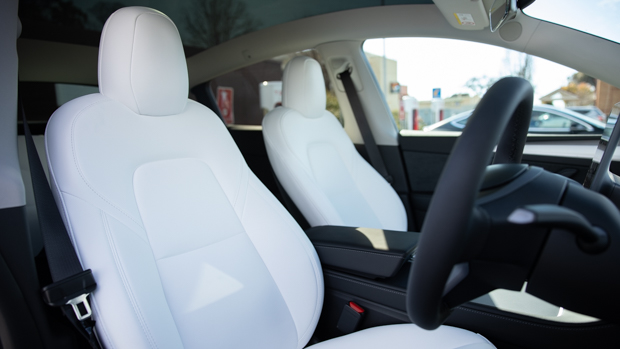
Material quality is impressive, with soft padding on the doors, dashboard and centre console. It’s pleasant that the dual Qi-wireless chargers are trimmed in microfibre to prevent scratching to caseless phones. It’s a shame you can’t pair the attractive wood trim from the black interior with the more chic, cooler-in-summer white upholstery.
So, that touchscreen: like the Model 3, effectively all vehicle functions are driven through the 15-inch slate that sits proud in the centre of the dashboard in both left-hand and right-hand drive cars, saving production costs. The screen is bright and the resolution is crisp.
The many positives of this display include the clean software design, intuitive settings tray and a stacked app-driven layout with a dedicated data connection driving Google Maps-backed navigation, Spotify, YouTube, Twitch, Netflix and other services. Basic nav and Bluetooth media streaming is standard but the more immersive stuff requires a $9.99/month subscription which is decent value.
But the screen isn’t perfect. Even your speed sits in the central display, with shades of Toyota Echo or Nissan X-Trail from the early 2000s. No head-up display is fitted, nor is a small instrument cluster like that found on the updated Tesla Model S sedan. This continues to feel like a compromise too far, with a need to shift your eyes noticeably from the road to check your speed, which you do plenty of in a camera-obsessed nation like Australia.
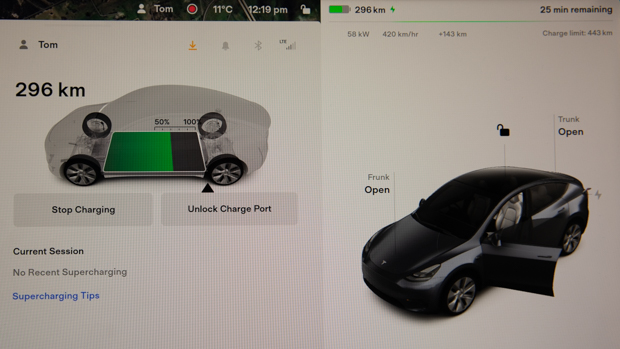
In the future if or when autonomous driving is legally permitted and technically honed, not having easy visibility of measures like speed might be a non-issue – but that era remains some way off locally, with the regulatory discussion barely broached in Australia.
We’re not entirely sold on the hidden vents for the air conditioner and heater. Air flow can left in automatic or diverted through the touchscreen, though it took considerable fine tuning by touch to direct air to our face in the driver’s seat. Simpler hardware vents get the job done in a quicker, safer manner.
But we like the small-diameter steering wheel which feels appropriate given the direct steering ratio. The vegan wheel trimming is one of the best we’ve used, avoiding palm sweat, while the simple combined scroll wheel/jog dials work well once you’ve mastered what the left and right controls do (media and adaptive cruise settings, respectively).
Move to the second row and you’ll be amazed at the space on offer in this 4.7m-long SUV – legroom and toe room are vast, limo-like in fact, and a third person can be genuinely accommodated in the Model Y thanks to decent shoulder room, a flat floor and the fact the first-row centre console does not protrude into the rear space.
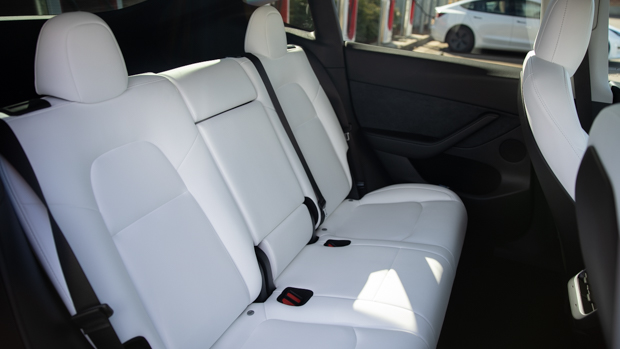
Air vents (with physical adjustment), two USB-C ports (in addition of two up front), 40/20/40 folding seats, a centre armrest and soft-touch materials are all standard in the generous back seat, while the thigh angle of the bench is better than in many electric cars, allowing for more comfortable back-seat travel on road trips.
While it goes without a spare wheel and tyre – like many EVs – the Model Y lands a real punch in terms of cargo-area practicality. In addition to a generous 117-litre weather-sealed froot/frunk, Tesla claims this SUV has a 854-litre boot. That huge number seems feasible once you notice the massive underfloor storage area that is as large as the frunk – though some Australian buyers would prefer Tesla had used that space to jam a spare in.
Translating the literage numbers, the Model Y has reset the benchmark for most cargo space in a luxury midsize SUV with our more tangible soccer ball test. We fit 12 of our footballs into the frunk, 12 more in the under-boot storage area, and 48 in the boot itself beneath the window line. That’s very impressive.
Compared to similarly-priced and similarly-sized electric SUVs, the Model Y RWD is cheaper to run because of its relative efficiency and small-ish battery. While range could be better, the Model Y requires fewer volts per kilometre than virtually all rivals.
That said, the lower, more aerodynamic Model 3 sedan – which also has five seats but a smaller boot – is much more efficient again. In our mixed 600km test, which took in urban and rural roads, plus highways, we managed 16kWh/100km – good for a real-world range of 375km, rather than the 455km (WLTP) claimed by Tesla.
Range aside, the Model Y remains inexpensive to fuel for a midsize SUV. Charging at home at a tariff of $0.25/kWh means it’d cost $15 to fill from empty to full (0-375km), while the same charge would cost about $31 on a Tesla supercharger ($0.51/kWh) or $36 on the Chargefox or Evie ultra-rapid charging networks ($0.60/kWh).
Most of the Model Y’s electric SUV rivals – the Kia EV6, Hyundai Ioniq 5 and Mercedes-Benz EQA, use 10-20 percent more electricity per kilometre, meaning their charging costs are 10-20 percent higher – and those cars can’t access Tesla’s reliable Supercharger network.
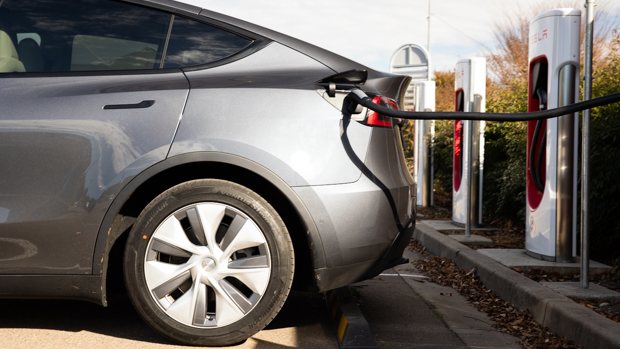
And by comparison, to fuel an Audi Q5 for 375km of range costs about $75 while petrol is $2.20 per litre. The diesel Q5 would cost about $45 to drive 375km.
Tesla does not reveal servicing prices for the Model Y, partially because it is maintained based on condition, not time – unlike nearly all rivals. This servicing isn’t free, though, and Tesla suggests budgeting for tyre rotation/balance/wheel alignment every year, cabin filters and a brake fluid test every two years, a HEPA filter replacement every three years, and air conditioning dessicant bag replacement every four years.
Finally, to warranty: it’s four years/80,000km for the vehicle, which is short; nearly all new cars sold in Australia now carry a five year/unlimited kilometre warranty. Among similar EVs, only the three year/unlimited kilometre warranty of the BMW iX3 is shorter by time.
The Model Y’s high-voltage component warranty is a more standard five years/160,000km with the LFP battery (RWD) or five years/192,000km for the nickel-cobalt-aluminium battery (Performance AWD).
If you’re ready to move into a fully-electric midsize SUV right now, no car makes life as easy as the Tesla Model Y – which is why we recommend this vehicle. This brand’s exclusive, reliable, plentiful charging network is absolutely central to this recommendation. Charging the Model Y is easy, quick, and still relatively cheap.
But the result would be a slam-dunk for the Model Y if the suspension was better. This SUV doesn’t ride comfortably. The stiff ride quality partially gives the Model Y its fun handling, but the tradeoff is a brittle, bump-prone ride at low speed. Rivals like the Kia EV6 strike a better balance.
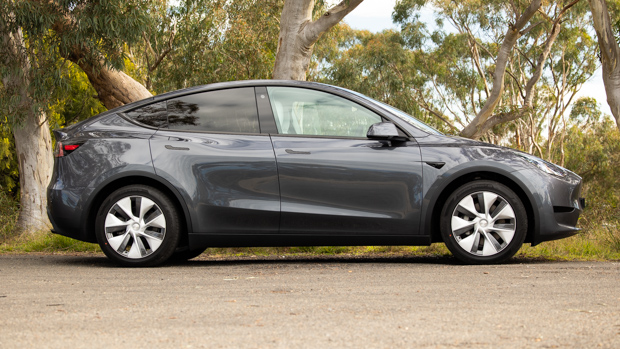
With the Model Y RWD being positioned as a practical, family crossover, it needs a practical, supple, sleeping-baby-friendly ride, and its dampers deserve a retune in future. We’d also like to see a HUD or tidy little instrument cluster added, though we don’t hold out hope for the latter given Tesla’s intentional decision to declutter the cabin.
When it comes to motor smoothness, efficiency, relative value for money, interior tech, seat comfort – and most of all ease of charging – the Model Y impresses. This crossover has a broad set of talents, hence our aspiration that Tesla can get ride quality right in future.
Variant tested REAR-WHEEL DRIVE
Key specs (as tested)
About Chasing cars
Chasing Cars reviews are 100% independent.
Because we are powered by Budget Direct Insurance, we don’t receive advertising or sales revenue from car manufacturers.
We’re truly independent – giving you Australia’s best car reviews.
The estimate provided does not take into account your personal circumstances but is intended to give a general indication of the cost of insurance, in order to obtain a complete quote, please visit www.budgetdirect.com.au. Estimate includes 15%^ online discount.
^Conditions Apply
Budget Direct Insurance arranged by Auto & General Services Pty Ltd ACN 003 617 909(AGS) AFSL 241 411, for and on behalf of the insurer, Auto & General Insurance Company Limited(ABN 42 111 586 353, AFSL 285 571).Because we don’t know your financial needs, we can’t advise you if this insurance will suit you. You should consider your needs and the Product Disclosure Statement before making a decision to buy insurance. Terms and conditions apply.
Indicative quote based on assumptions including postcode , 40 year old male with no offences, licence suspensions or claims in the last 5 years, a NCD Rating 1 and no younger drivers listed. White car, driven up to 10,000kms a year, unfinanced, with no modifications, factory options and/or non-standard accessories, private use only and garaged at night.
^Online Discounts Terms & Conditions
1. Discounts apply to the premium paid for a new Budget Direct Gold Comprehensive Car Insurance, Third Party Property Only or Third Party Property, Fire & Theft Insurance policy initiated online on or after 29 March 2017. Discounts do not apply to optional Roadside Assistance.
2. Discounts do not apply to any renewal offer of insurance.
3. Discounts only apply to the insurance portion of the premium. Discounts are applied before government charges, taxes, levies and fees, including instalment processing fees (as applicable). The full extent of discounts may therefore be impacted.
4. We reserve the right to change the offer without notice.